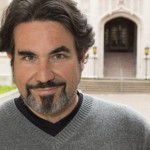Image credit: Articulating Media Arts Activities in Art-Science Contexts © 2015 Angus Graeme Forbes, University of Illinois at Chicago
This Q&A is part of a series of interviews with some of the creative minds behind SIGGRAPH 2016. Meet Edward Shanken, Ph.D., Associate Professor, Digital+Media, Rhode Island School of Design, SIGGRAPH 2016 Art Papers Chair. Submissions are now being accepted.
SIGGRAPH 2016 (S2016): Where does your core inspiration come from?
Edward Shanken (ES): I’m inspired by how, throughout history, artists have used the latest scientific models and technological media to envision the future and to create working models that allow us to get a little taste of it in the present. I’m equally interested in how transdisciplinary collaboration — especially at the intersections of art, design, science, and engineering — fuels innovation: Innovation not just as an immediately marketable commodity or military capability, but as constituting subtle, insidious, and profound shifts in the conception and construction of knowledge and society.
(S2016): Can you briefly describe your program vision.
(ES): Art Papers consistently generates top-level scholarship that contributes to our understanding of the history of art, informs contemporary artistic and critical practices, and anticipates and stimulates future trajectories. This year we are especially encouraging papers that address transdisciplinary research at the frontiers of art, design, science, and engineering that is engaged with critical and speculative practices, that expand the international and cultural breadth of SIGGRAPH discourses, and that dovetail with the 2016 Art Papers theme, “Data Materialities.”
(S2016): Tell us about the trends in the digital art space right now that you are most excited about.
(ES): One of the 2015 Art Papers described a novel use of photographs in an esoteric programming language (esolang). Esolangs are elaborate and non-instrumental, more than slightly absurd and often highly poetic, blurring the boundaries between code and art. They typically generate no more than the standard “Hello world” statement, so it’s more about the journey than the destination. The growing embrace of transdisciplinary art research, the topic of another 2015 Art Paper and the November 2015 NAKFI conference is very exciting. And I’m also very keen on current art research that explores the fluidity between actual and virtual objects, which examines the circulation of images via social networks, and that questions anthropocentric epistemological constructs and instantiates what philosopher Graham Harman has theorized as “object oriented ontology.”
(S2016): How are these trends giving artists new tools to play with and what do you find most exciting about that?
(ES): It’s not a matter of engineers creating tools that artists play with. It’s more about the circulation and negotiation of ideas through material practices that operate in a liminal field less constrained by instrumental functionality, in which a chain of unforeseen accesses open up, offering alternative metaphors and insights into possible futures.
(S2016): Tell us about the moment you got involved in the Art Gallery and what SIGGRAPH has meant for both your personal and professional growth.
(ES): 2016 will be the 15th anniversary of my first SIGGRAPH, when, fresh out of grad school, I presented what has become my most highly cited essay. It was a great experience for me and made important contributions to my personal and professional growth. Over the years, I’ve given papers, chaired panels, and served on SIGGRAPH juries, meeting and strengthening ties with some wonderful artists and scholars, who have played a vital role in my career.
 Edward A. Shanken is an American art historian, whose work focuses on the entwinement of art, science and technology, with a focus on experimental new media art and visual culture. His scholarship has appeared in numerous journals and anthologies and has been translated into six languages. He received his Ph.D. in Art History from Duke University.
Edward A. Shanken is an American art historian, whose work focuses on the entwinement of art, science and technology, with a focus on experimental new media art and visual culture. His scholarship has appeared in numerous journals and anthologies and has been translated into six languages. He received his Ph.D. in Art History from Duke University.





Leave a Reply